At La Closette, we’re avid vintage and resale shoppers for you (and for yourselves!), and today I’ll tell you why.
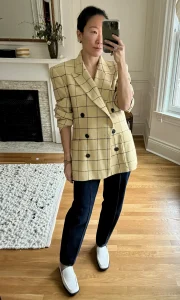
1) Vintage adds nuance and depth to your style
I’ll start purely from an aesthetic point of view: If there’s anything my job has taught me, it’s that understanding your personal style is something that takes years — by years, I mean decades — to develop. For myself included! Even now (full disclosure: I’m 42), everyday I move towards a style that is more authentically me, which tracks with what I see in others: that it usually takes until your 30s (at least) to get a good handle of your personal style.
And that makes sense because — let’s be honest — your teens, 20s and even 30s are a gong show of trying on different selves and figuring out your place in the world. (Can you relate or is this just me projecting?) By my age, we’re unpacking all the sh*t from the past 40 years, giving less f*cks about what others think and (hopefully) finally living for ourselves.
It’s why I see a lot of on-trend 20-year-olds, but can’t help but feel that their style lacks the nuance and point of view that makes it their own. Another way of saying this is that their style has a point of view, but it’s the view espoused in celebrity culture, by a particular brand and on social media, and not really theirs.
On the other hand, when I see stylish women in their 60s+, they may be wearing nothing current, but the way they style and carry their clothes seems imbued with a lifetime of experience. Sometimes I can’t help but stare and wonder more about them — their life, where they’ve been and what they’ve seen.
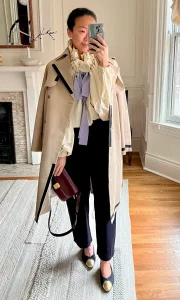
That’s the thing about authentic personal style — it communicates your story. It’s something that’s true to you, and only you, and no fashion magazine, brand, or marketing professional can determine despite all their “market research.”
By just following the trends and buying what’s in store now, you can end up with a wardrobe that feels cookie-cutter and one-dimensional. Expanding your scope to vintage and resale allows you to tap into decades of fashion from designers who have come and gone, who were inspired by the cultural and social mood of the time, and also fashion from around the world.
You are the three-dimensional (4D, if we’re getting metaphysical!) sum of your whole life experience; wouldn’t it be wonderful to reflect that in your clothes everyday? Vintage helps you do that. Every piece brings its own history you can carry with you, and conversely, you now impart your own interpretation to it.
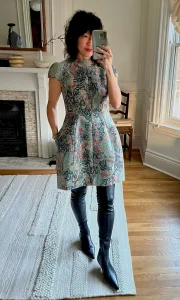
2) Cost considerations of vintage style
One of the most appealing considerations of shopping vintage/resale is that pieces usually cost (far) less than what you would have bought them for at retail. As a teenager who loved clothes but didn’t have the money to buy much, my local Salvation Army allowed me to experiment with style.
Price points fall into three broad categories:
“Thrifted”: I consider these the pieces you find at Goodwill, or anywhere really, at single digit-to-low-double digit price points. It’s the no-name cotton dress shirt that’s perfectly oversized or the vintage cowboy boots that are worked in just the right amount. It could also be a pennies-to-the-dollar score: like the vintage Pierre Cardin leather blazer I found for $12 or the vintage Celine silk shirt I found for $5 (!!) that slipped past the sorter. Oops!
“Consignment” or “Resale”: These are the pieces by recognizable brands which are selling at less than retail — it could be at a 20% discount or 80%. Toronto-based VSP Consignment falls into this category, as does online retailer The RealReal, Paris-based RESEE, Poshmark and similar websites.
Vintage collectibles: These are pieces that are often quite expensive, whether it’s because they’re rare or have historical significance. One of my favourite vintage sites is Etéreo Vintage which sells stunning pieces like this 70s YSL Rive Gauche dress (US$2,098) or this Romeo Gigli tiered skirt (US$2,998).
3) Quality considerations
Older (20+ years) and luxury clothes are usually much better made than what is sold in stores today. Unsurprisingly, the quality decline correlates with the explosion of fast fashion in the 1990s, the greater outsourcing of production to low-cost labor around the world and less oversight of the production process (an on-going conversation for another post).
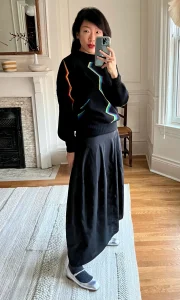
4) Environmental considerations
And probably the most pressing issue is the impact of our choices on climate change. Earlier this week, the Intergovernmental Panel of Climate Change, a body of experts convened by the United Nations, released its report which concluded that the planet is likely to cross a critical threshold for global warming within the next decade, and nations will need to make an immediate and drastic shift away from fossil fuels to prevent the planet from overheating dangerously beyond that level.
Fashion is now one of the most polluting industries in the world. Gone are the days when people had few but well made, durable pieces. Too much of our clothing ends up in the landfill, rather than buying less, more carefully, and reusing what we already have. If you haven’t already, I highly recommend following Amanda from Clotheshorse on Instagram: she advocates slow fashion through her wealth of knowledge about the fashion industry, supply chains, fabrics, marketing tactics, etc… I’ve learned so much from her account.
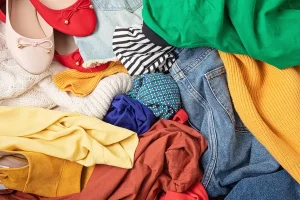
All of these reasons make shopping vintage, consignment and resale a smart option. If you want help with adding pieces to your wardrobe, get in touch!
________________________________________________________________
If you’re interested in more content like this, check out Irene’s personal newsletter, In Moda Veritas.


